Hobbs Aerobic Digester Replacement Wins ACEC NM Engineering Excellence Award
The Hobbs Aerobic Digester Replacement is an excellent example of a client, engineer, and contractor working together to bring maximum value to a public infrastructure project. The City knew what they wanted, the design team knew how to define the project concepts and apply science to technology. And the contractor knew how to bring it all into physical reality.
From the earliest planning stages to the final facility start-up, the primary objective was to provide a high-quality, efficient treatment system that represents maximum value and serves the community’s needs for decades to come. Every person on the project contributed to this goal.
The team’s most important contributions were:
1) developing a unique configuration to maximize digestion efficiency
2) creating thorough, complete construction documents and
3) facilitating the construction process to create a high-quality end product

Water reclamation facilities, just by their nature, are complex projects to plan and design. They involve the careful coordination of every major engineering discipline—civil, biological processes, electrical, instrumentation/controls, mechanical systems, and structural.
Background, Issues, and Goals
The Hobbs Wastewater Reclamation Facility was initially constructed in the 1980s as a conventional activated sludge oxidation facility with secondary clarifiers and sludge holding tanks. Various improvements during the 1990s and the last expansion in 2008 increased the facility’s capacity to its current state, which included the conversion of old secondary aeration basins into aerobic digesters. This digester setup had issues related to tank leakage, equipment failures, and operational challenges related to the process design parameters. The City of Hobbs initiated this aerobic digester replacement to rectify these issues and achieve the following stated goals:
- Continue producing Class A biosolids per the US EPA Part 503 regulations.
- Address structural integrity concerns of all system components and operations concerns related to confined space entry to ensure the safety and reliability of the solids handling process.
- Optimize the efficiency of the digestion process during both summer and winter conditions.
- Minimize the cost of maintenance of digester equipment.
- Implement a facility design that represents the best value for the City of Hobbs residents.
Designing the Improvements
Before initiating the final design effort, a thorough evaluation of the Preliminary Engineering Report (PER) recommended project was performed to ensure that the final project outcome was consistent with the City’s stated goals to the maximum extent possible.
With the final design criteria established and the basin equipment selections made, the BHI team designed the improvements, including sludge conveyance into and out of the digesters, two pump rooms to house the motive pumps, aeration blowers, piping, and all electrical and instrumentation.

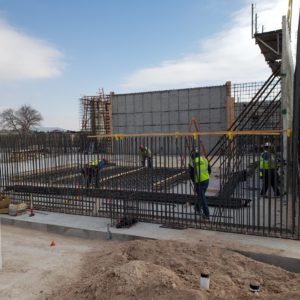
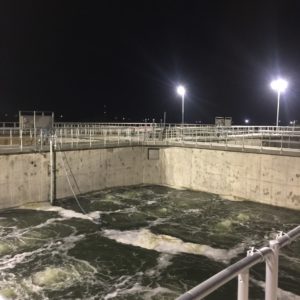
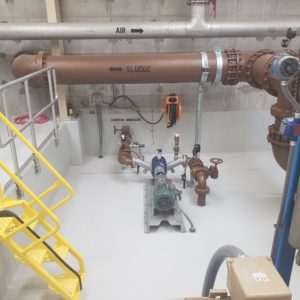
The Old and The New
Even brand-new facilities require very detailed efforts. When combining this aspect of the work at an existing facility, the complexity becomes magnified by the constraints. Fitting the old and new together becomes an iterative process of starting with one discipline-specific goal of the planning effort, creating a solution, then checking it to make sure that the design parameters of all the other disciplines are likewise validated. If not, corrections are made, and the process repeats until a final inclusive solution is achieved. The significant complexities of the project can be divided into three main categories.
Basin Configuration and Profile
Site constraints and the preferred jet aeration configuration required careful coordination between the various engineering disciplines. The pump/blower rooms needed to be attached to the digester basins to minimize long pipe reaches on the suction and discharge sides. The elevation of the inlet and outlet relative to the basin floor was also significant. And there was a desire to limit the height of the basins above ground and not create confined space access in the facility. Making sure the metal building structures had adequate roof slope and a watertight intersection with the basin wall was also important.
The final design layout and profile required multiple iterations to reconcile all of the site and design constraints. It included a split-level floor plan with the blowers on the upper level and the pumps 3.1 feet lower. To meet all the site constraints, the minimum basin depth had to be below 20 feet.
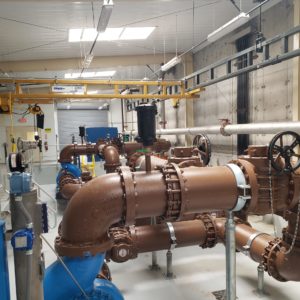

Four-Basins, Two Stages, Optimal Efficiency
The BHI team worked closely with the City’s operations staff and developed a method to maintain a cost-effective balance between the digester sludge age and the digester basin volume, coupled with the aeration and mixing requirements for the basins and the day-to-day activities required to run the system.
A four-basin aerobic digester system was designed to operate as two parallel trains and two stages. The facility was designed to accept Waste Activated Sludge (WAS) or Thickened Waste Activated Sludge (TWAS) from the drum thickeners with the solids concentrations less than 3%. WAS. TWAS is pumped to either of the Stage 1 digesters. The sludge then flows into a common splitter box and is diverted to Stage 2 digesters. Using the splitter box and a sluice gate between the Stage 2 digesters, the basins can be operated as a three-stage process to further enhance biosolids stabilization if needed. Stabilized sludge from Stage 2 digesters is pumped to the centrifuge for dewatering before being dried and sent to compost.
Telescoping valves installed in all four basins allow the City to decant supernatant off from the basins back to the headworks. This two-stage design allows the City to provide continuous biosolids processing in either one or both parallel trains and to maximize the amount of sludge stored.
Sludge storage allows the City to maximize the efficiency of the sludge drying process by varying the number of times and days per drying that the sludge drier is operated at any given time of year.
The staged digester system design significantly increased the efficiency of the aerobic digestion process for the current and future flows expected at the treatment plant. It likely eliminated the need for future digester basins identified in the PER.
Merging Instrumentation and Controls
The adage that “the only thing constant is change” applies to the realm of instrumentation and control. The transition to digital technologies within wastewater treatment process control is constantly evolving and accelerating, with emerging technologies providing better information with lower failure rates and less operator maintenance.
This project’s most critical integration of process controls revolved around coordinating an operating scheme between Parkson’s main control panels and the Aerzen blowers. This required “handshaking” schemes between the controllers to ensure the blowers were capable of the varying duty points requested of them while staying within their air pressure and temperature boundary conditions.
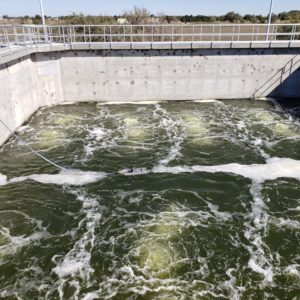
A trio of instruments provided various sludge conditions within each basin – water level, pH, and dissolved oxygen. This information can be monitored in real-time to allow the operator to assess and determine where incoming thickened sludge should be routed while making judgments during scheduled drying cycles about the maximum volume of digested sludge to be extracted by constantly monitoring the solids content sent to the final dewatering process. Without this information flow, it is much more difficult for an operator to manage the overall process to the optimum energy efficiency while maintaining the digester biomass properly.
The Water Reclamation Facility already had a plant-wide Supervisory Control and Data Acquisition (SCADA) system in place, and the new digester facility was effectively an extension to the fiber-optic network ring throughout the plant. The new controllers were brought onto the network to allow the new digester information to be merged into the plant SCADA, allowing monitoring of critical processes, remote control decisions, and historical charting of data for reporting purposes and situation analysis.
From Concept to Completion….and Stellar Start-Up Services
During construction, the BHI team provided construction phase services to ensure that the project was built in compliance with the final plans and specifications. The $9.4 million construction project was completed on a 15-month construction schedule and to a final construction budget that was just 4.6% higher than the original contractor bid price after additional work was added to the original scope of work.
The BHI team also provided project performance evaluation and reporting for a 1-year period after the new digesters were brought online. The performance evaluation tracked operational issues and the mechanical performance of all the system components. It also followed major process design parameters for the facility, including sludge yields, inlet and outlet sludge flow rates, solids retention time, solids concentrations, volatile solids destruction, temperatures, ammonia, and nitrate concentrations. The BHI team worked with the plant operators to experiment with process variables like aeration cycle times, decanting schedules, wasting period lengths, and timing and provided suggestions to optimize the facility’s performance. Mechanical issues that arose were coordinated with the contractor and major equipment suppliers to get resolved as quickly as possible. By the end of the performance period, the system met or exceeded all permitting and process parameters designed into the facility.
